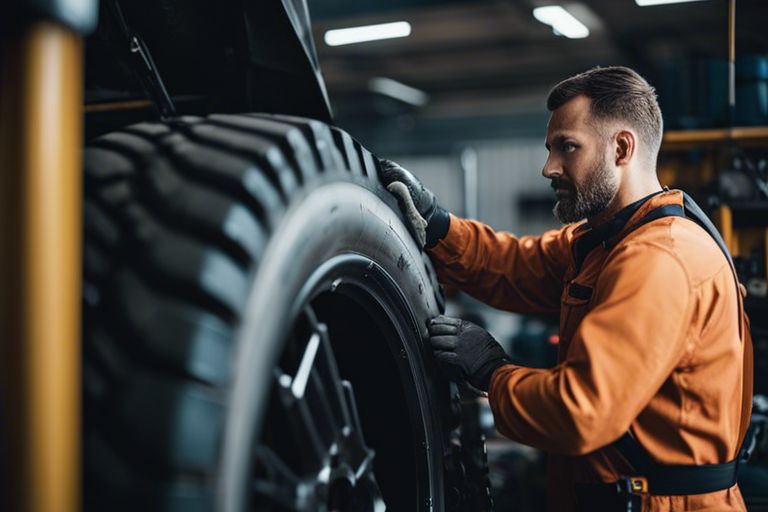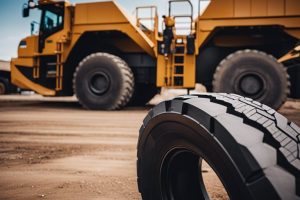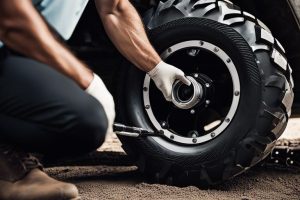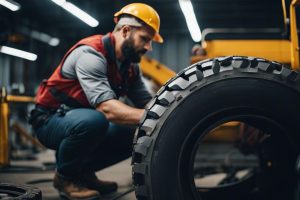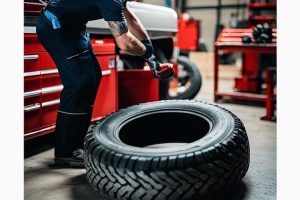Embark on a journey towards mastering the art of repairing OTR tires with our expert tips tailored for professionals in the field. Navigating the intricacies of off-the-road tire repair requires precision and knowledge to ensure safety and longevity. In this comprehensive guide, we will examine into the critical steps and techniques needed to effectively repair OTR tires. For more EXPERT TIPS #5 HOW BIG IS TOO BIG? REPAIRING…
Key Takeaways:
- Proper Inspection: Conduct a thorough inspection of the OTR tires to identify the extent of damage before starting the repair process.
- Correct Patching Technique: Use the appropriate tools and materials to patch the tire carefully to ensure a reliable and long-lasting repair.
- Follow Industry Standards: Adhere to industry guidelines and best practices for repairing OTR tires to maintain safety and performance standards.
Essentials of OTR Tire Repair
Now, let’s investigate into the key aspects of repairing Off-The-Road (OTR) tires. Whether you are a seasoned professional or just starting in the industry, understanding the crucials of OTR tire repair is crucial to ensuring the safety and efficiency of heavy machinery.
Factors Influencing OTR Tire Repair
On any OTR tire repair job, several factors come into play that can significantly impact the repair process. The size and type of damage on the tire will determine the repair technique needed. Additionally, the condition of the tire itself, including any previous repairs or wear, can affect the overall success of the repair.
- Environmental conditions such as temperature and humidity.
- The quality of the repair materials used.
- Operator expertise in handling and repairing OTR tires.
- Assume that proper safety protocols are followed at all times.
Tools and Equipment Checklist
On every OTR tire repair job, having the right tools and equipment is crucial for a successful repair. From tire inspection to patching and inflation, each step requires specific tools to ensure the job is done correctly and safely.
With a high-quality tire repair kit, including patches, plugs, and sealants, professionals can effectively address various types of tire damage. Investing in a reliable tire pressure gauge and inflation system is also crucial for ensuring the repaired tire meets the manufacturer’s specifications for proper inflation.
Step-by-Step Repair Procedures
The repair of OTR tires requires a systematic approach to ensure efficiency and safety. By following step-by-step procedures, professionals can effectively repair these heavy-duty tires, extending their lifespan and performance.
| Initial Assessment and Damage Evaluation | How-to Execute a Safe and Effective Repair |
|
Assessment – Before starting any repair work on an OTR tire, it is crucial to conduct a thorough assessment of the damage. This includes checking for punctures, cuts, bulges, and any other signs of wear and tear. By evaluating the extent of the damage, professionals can determine the appropriate repair techniques needed for the safety and efficiency of the repair process. Once the assessment is complete, it is necessary to identify the root cause of the damage to prevent any future issues. By carefully examining the tire, professionals can diagnose the problem areas and determine the best course of action for repair. |
The execution of a safe and effective repair process requires close attention to detail and adherence to industry standards. Professionals must follow the recommended repair procedures for OTR tires to ensure optimal safety and performance. By using high-quality materials and techniques, professionals can successfully repair OTR tires without compromising their integrity. |
How-to Execute a Safe and Effective Repair
Effective repair of OTR tires is critical for the safety of heavy machinery and operators. Properly executing repair procedures ensures that the tires can withstanding the rigors of challenging terrain and long hours of operation. By adhering to best practices and professional guidelines, repair technicians can maintain the performance and durability of OTR tires effectively.
Advanced Tips for OTR Tire Repair
All professionals in the OTR tire repair industry know that sometimes, standard repair methods may not be enough. In such cases, advanced techniques and tips come in handy to ensure thorough and effective repairs. Here, we probe into some advanced tips that can help you tackle even the most challenging OTR tire repair jobs with confidence.
-
Troubleshooting Common Repair Challenges
Challenge Solution Difficulty in locating leaks Use a water tank with compressed air to pinpoint leak sources. Repair patch not adhering properly Prep the area thoroughly, ensuring it is clean and dry before applying the patch. Damage near the sidewall Consider using a specialized sidewall repair kit for a secure and lasting fix. -
Enhancing Repair Efficiency and Durability
Tip Benefit Use high-quality repair materials Ensures long-lasting repairs and prevents future issues. Invest in specialized tools Increases efficiency and accuracy in repair work. Implement proper curing techniques Enhances the bond strength of repair patches for durable fixes.
Troubleshooting Common Repair Challenges
For professionals facing common repair challenges like difficulty in locating leaks, patch adhesion issues, or damage near the sidewall, it is crucial to approach each issue methodically. By using a water tank with compressed air to identify leaks, ensuring thorough preparation of the repair area, and considering specialized kits for sidewall damage, you can effectively overcome these obstacles and achieve successful repairs.
Enhancing Repair Efficiency and Durability
On the quest to enhance repair efficiency and durability, investing in high-quality repair materials, specialized tools, and implementing proper curing techniques is vital. By utilizing top-notch materials and tools, professionals can ensure long-lasting, reliable repairs that withstand harsh operating conditions in the OTR tire industry.
It is crucial to prioritize repair quality above all else, as subpar repairs can compromise the safety and performance of OTR tires. By following advanced tips and techniques, professionals can elevate their repair standards and deliver top-notch services that meet the demanding requirements of the industry.
Maintaining Repaired OTR Tires
Unlike regular tires, Off-The-Road (OTR) tires undergo extreme conditions and require special care and attention after being repaired. Proper maintenance is crucial to ensure the longevity and performance of the repaired tires.
How-to Conduct Post-Repair Inspections
Tires that have been repaired need to undergo thorough post-repair inspections to check for any anomalies or signs of potential issues. Inspections should include checking for proper sealing of the repair area, monitoring any changes in tire pressure, and examining the overall condition of the tread and sidewalls. Additionally, it is important to visually inspect for any irregular wear patterns that may indicate alignment or balance issues.
Regular inspections post-repair help in detecting any early signs of damage or issues that could lead to further tire deterioration. It is recommended to conduct these inspections at regular intervals to ensure the repaired tires are in optimal condition for continued use in demanding OTR applications.
Tips for Extending the Life of Repaired Tires
Repaired OTR tires can have a prolonged lifespan with proper care and maintenance. Some tips to extend the life of repaired tires include maintaining proper tire inflation pressure, adhering to recommended load capacities, and avoiding overloading the tires. Regularly rotating the tires and aligning the wheels can also help distribute wear evenly and extend tire life.
- Proper tire inflation and regular pressure checks are important for tire longevity.
- Adhering to load capacities and avoiding overloading can prevent premature tire wear.
- Regular tire rotations and wheel alignments distribute wear and extend tire life.
Knowing the right maintenance practices for repaired OTR tires is crucial in ensuring the safety and efficiency of heavy machinery operating in tough terrains. By following these tips, professionals can maximize the performance and lifespan of repaired tires, ultimately lowering operating costs and reducing downtime.
Conclusion
Now armed with important how-to tips for repairing OTR tires, professionals in the industry can confidently tackle any repair job with precision and efficiency. By following expert advice and best practices, professionals can ensure the safety and longevity of OTR tires, ultimately saving time and money for their clients. By staying informed and practicing these tips, professionals can continue to excel in the field and provide top-notch service to their customers.
FAQ
Q: What are some necessary tips for repairing OTR tires?
A: When repairing OTR (Off-The-Road) tires, it is crucial to first assess the damage properly. Ensure that the tire is suitable for repair and that the damage is within the repairable limits set by industry standards. Additionally, always use high-quality repair materials and follow the recommended repair procedures to ensure the tire’s safety and longevity.
Q: How can professionals effectively repair OTR tires?
A: Professionals can effectively repair OTR tires by staying updated with the latest industry standards and techniques for tire repair. It is necessary to have the right tools and equipment for the job, as well as the expertise to identify the type of damage and determine the appropriate repair method. By following best practices and guidelines, professionals can ensure safe and reliable OTR tire repairs.
Q: What are some common mistakes to avoid when repairing OTR tires?
A: One common mistake to avoid when repairing OTR tires is neglecting proper cleaning and preparation of the damaged area before repair. Failing to remove contaminants or moisture can lead to repair failure and compromise the tire’s integrity. It is also crucial to not exceed the maximum repairable area or attempt to repair tires with extensive damage that is beyond repair limits. Lastly, using substandard repair materials or techniques can result in unsafe tire conditions, so it’s important to always follow industry best practices.
